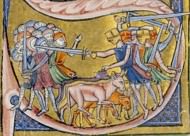
If, as August Nitschke argued, “groups can be understood most clearly when we ask: how do they look at their enemies?” then a good litmus test for Middle Eastem Islamic attitudes with regard to Western Christianity during the Middle Ages should be provided by the Crusades. Were they really that “great debate between East and West” that Edward Gibbon wrote about? When one begins to peruse the Islamic sources a paradox leaps immediately to the eyes: though the First Crusade was preceded by, generated, and was followed by a powerful outburst of religious enthusiasm (not to say frenzy) on the Christian side, among Muslims one encounters at first very little religious animosity towards the invaders, and certainly no corresponding religious resurgence. Panic, anguish, and hatred were indeed created by this forceful irruption into Syria- Palestine in 1097-1100, yet they lack an Islamic dimension. This is to be explained in part by  the fact that the Crusades were viewed by the Syrians as an extension of Byzantine military campaigns aimed at the reconquest of Northern Syria in the tenth and eleventh centuries; campaigns which were on the whole (with one exception, the campaigns of Nicephoros Phocas and John Tzimisces in the third quarter of the tenth century) devoid of religious characteristics: a war between states, not between inimical religions. Such a perception was rendered plausible by the fact that the Crusaders came to Syria via Constantinople and that Western Europeans (Franks) had been known in the Middle East in the past, especially as mercenaries of the Byzantine Empire (p. ex. during the 1071 battle of Manzikert).
the fact that the Crusades were viewed by the Syrians as an extension of Byzantine military campaigns aimed at the reconquest of Northern Syria in the tenth and eleventh centuries; campaigns which were on the whole (with one exception, the campaigns of Nicephoros Phocas and John Tzimisces in the third quarter of the tenth century) devoid of religious characteristics: a war between states, not between inimical religions. Such a perception was rendered plausible by the fact that the Crusaders came to Syria via Constantinople and that Western Europeans (Franks) had been known in the Middle East in the past, especially as mercenaries of the Byzantine Empire (p. ex. during the 1071 battle of Manzikert).
 the fact that the Crusades were viewed by the Syrians as an extension of Byzantine military campaigns aimed at the reconquest of Northern Syria in the tenth and eleventh centuries; campaigns which were on the whole (with one exception, the campaigns of Nicephoros Phocas and John Tzimisces in the third quarter of the tenth century) devoid of religious characteristics: a war between states, not between inimical religions. Such a perception was rendered plausible by the fact that the Crusaders came to Syria via Constantinople and that Western Europeans (Franks) had been known in the Middle East in the past, especially as mercenaries of the Byzantine Empire (p. ex. during the 1071 battle of Manzikert).
the fact that the Crusades were viewed by the Syrians as an extension of Byzantine military campaigns aimed at the reconquest of Northern Syria in the tenth and eleventh centuries; campaigns which were on the whole (with one exception, the campaigns of Nicephoros Phocas and John Tzimisces in the third quarter of the tenth century) devoid of religious characteristics: a war between states, not between inimical religions. Such a perception was rendered plausible by the fact that the Crusaders came to Syria via Constantinople and that Western Europeans (Franks) had been known in the Middle East in the past, especially as mercenaries of the Byzantine Empire (p. ex. during the 1071 battle of Manzikert).
